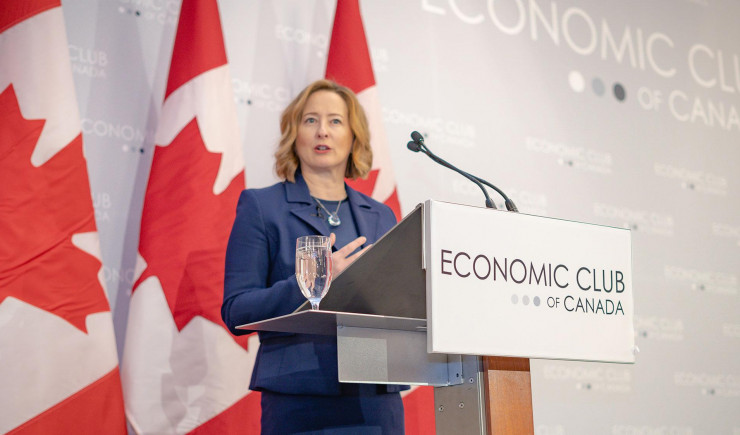
Governance
The Bank of Canada Act provides the legal authority and framework for governance of the Bank of Canada. Several important governance changes occurred in 2020.
Tiff Macklem was appointed Governor of the Bank for a seven-year term, effective June 3. Governor Macklem replaced former Governor Stephen S. Poloz, who left the Bank at the end of his seven-year term on June 2.
Pursuant to the Bank of Canada Act, the Governor is both:
- Chief Executive Officer of the Bank
- Chair of its Board of Directors
The independent (non-management) directors elect a lead director for a two-year renewable term to act as a key point of contact with the Governor. Claire M. C. Kennedy was reconfirmed as lead director in September.
In September, the Board of Directors announced that Senior Deputy Governor Carolyn A. Wilkins would not be seeking a second term. Her last day with the Bank was December 9.
Following the onset of the COVID‑19 pandemic, all governance activities—including meetings of the Board of Directors, Governing Council, Senior Management Council and supporting sub-committees—were conducted virtually. The annual out-of-town board meeting, which had been scheduled to take place in Vancouver in June 2020, was cancelled and replaced with a virtual meeting.
As Governor Poloz nears the end of his term, one of his proudest moments was unveiling the 1st bank note to feature a Canadian woman as portrait subject, in #Halifax. #ViolaDesmond #Vertical10 http://ow.ly/6gcE30qJL9P pic.twitter.com/GLQWxYVDww
— Bank of Canada @bankofcanadaMay 28, 2020

https://twitter.com/bankofcanada/status/1266006663108190211
Board of Directors
The Bank’s Board of Directors is composed of:
- the Governor
- the Senior Deputy Governor
- 12 independent directors
- the Deputy Minister of Finance (who is an ex officio non-voting member)
As Chair, the Governor leads the Board’s oversight responsibilities for corporate, financial and administrative matters. Monetary policy is neither formulated nor implemented by the Board. However, directors do provide insight from time to time on prevailing economic conditions in their respective regions and sectors.
All independent directors are appointed for three-year renewable terms by the Governor-in-Council.
The Bank of Canada Act and the Conflict of Interest Act specify eligibility requirements for members of the Board and outline rules to prevent conflict of interest.
The Board also requires its independent directors to follow the Code of Business Conduct and Ethics for Directors.
See the 2020 Board of Directors.
Committee structure and meetings
The Board of Directors has five standing committees, each of which has terms of reference and an annual work plan to guide its activities. The Bank of Canada Act also provides for an Executive Committee to act in place of the Board. Each committee of the Board, except the Pension Committee, consists solely of independent directors.
Bank of Canada management
Governor and Senior Deputy Governor
The Governor and Senior Deputy Governor are appointed for terms of seven years by the independent members of the Board of Directors, with the approval of the Governor-in-Council. The length of this term allows the Governor and Senior Deputy Governor to adopt a longer-term perspective. This is essential to the Bank’s effectiveness in:
- conducting monetary policy
- performing its other core functions
The salaries of the Governor and Senior Deputy Governor are determined by the Board within ranges established by the Government of Canada’s Advisory Committee on Senior Level Retention and Compensation. They are subject to approval by the Governor-in-Council.
Governing Council
Pursuant to the Bank of Canada Act, the Governor:
- has specific authority and responsibility for the business of the Bank
- is assisted by the Governing Council in oversight of the Bank’s core functions
Governing Council is composed of the Governor, Senior Deputy Governor and Deputy Governors.
Two internal committees are in place to provide advice:
- The Monetary Policy Review Committee assesses economic conditions in Canada and provides advice to the Governing Council on monetary policy.
- The Financial System Review Committee is the main forum for presenting and discussing issues related to the financial system.
Bank of Canada management structure
The Executive Council, composed of Governing Council and the Chief Operating Officer (COO), is responsible for assisting the Governor in oversight of the Bank’s strategic direction. As a member of Executive Council, the COO oversees:
- strategic and operational planning
- administration
- operations
The Leadership Forum—composed of the Executive Council, advisors and the managing directors from each department—focuses on:
- strategic Bank issues
- nurturing a leadership culture
The Senior Management Council is composed of both standing and rotating committee members from the Bank’s Leadership Forum. It supports the work of the Executive Council by overseeing:
- operational issues
- corporate programs
- strategic initiatives
- financial reporting
- annual planning
- related risks
Compliance and ethics
The Bank requires that all employees observe the highest standards of professional ethics. To this end, the Bank’s comprehensive Code of Business Conduct and Ethics is in place to address the personal and professional conduct of Bank employees. The Framework for Disclosure of Wrongdoing provides information to employees on how to report wrongdoing and outlines management’s role in disclosures, investigations and reporting.
The Code of Business Conduct and Ethics is reviewed annually by the Board.

